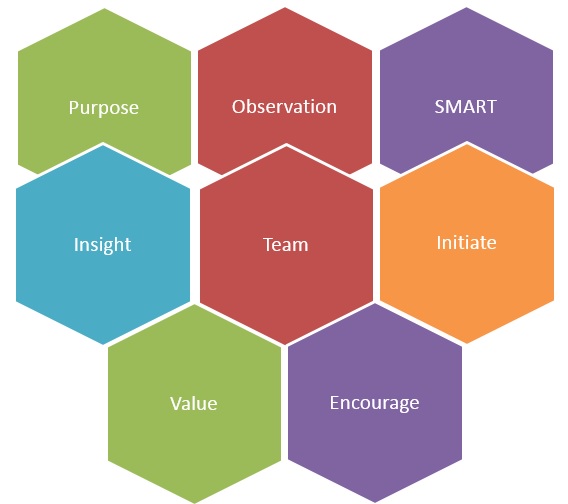Getting People Excited About Their Goals
We can all get excited about our goals when we're interested in what we're doing, and when we're getting plenty of support and encouragement from the people around us. So, how can you guide your team members so that they develop goals they'll be genuinely interested in for the long term? And how can you help them create strong networks of people who will give them support? The method is using coaching framework and model and one way to do this is with the POSITIVE model of coaching – an eight-step framework that you can use to develop highly motivating goals with your people.About the POSITIVE Model
Vincenzo Libri developed the POSITIVE Model of Coaching and published it in his 2004 article, "Beyond GROW: in Search of Acronyms and Coaching Models." POSITIVE stands for:- Purpose
- Observation
- SMART
- Insight
- Team
- Initiate
- Value
- Encourage
(Courtesy Mindtools Reproduced with permission.)
 The model encourages people to come up with long-term goals that excite them. It also gets them to build a support network as they work towards their objectives. This makes it more likely that they'll reach their goals.
The model encourages people to come up with long-term goals that excite them. It also gets them to build a support network as they work towards their objectives. This makes it more likely that they'll reach their goals. 
Applying the POSITIVE Framework
Follow the steps below to use the POSITIVE model.Step 1: Define Purpose
When you begin coaching someone, it's likely that she will already have a general idea of what she wants to achieve. However, she might not have a clear sense of how coaching can help her reach her objective. To clarify this with her, use the following questions:- What is your goal?
- How do you think coaching will help you reach it?
- What do you want to achieve in each coaching session?
Step 2: Make Observations
Once you've identified your coachee's goal and how coaching can help him achieve it, encourage him to think about his current situation from a variety of perspectives, so he can get a better understanding of it. Ask him to focus on the positive aspects, as well as the negative ones. Use these questions to probe further:- What is happening now?
- How do you feel?
- What's going well for you? What's not going so well?
- Why is your goal so important to you? How does it tie in with your overall career or job objectives?
- How do you think you can reach your goal?
- Who else knows about your intentions? Who else is affected?
- What parts of your life does this have an impact on?
- What would happen if you didn't take action?
- What have you already tried or achieved in relation to this goal?
Step 3: Develop a SMART Goal (Click here for the Worksheet)
Your coachee now has a general idea of what she wants to do, and has a good understanding of her current situation. You now need to help her define a SMART goal (so that it's Specific, Measurable, Attainable, Relevant, and Time-bound). Get her to write this down. Consider asking questions such as:- How important is this goal?
- How clear are you on it?
- What does success look like for you?
- How long do you have to reach this goal? Is this long enough? Or soon enough?
- How will you know when you've achieved it?
Step 4: Gain Insight
Next, your coachee needs to make sure that she has the will to achieve her goal. She should feel excited and motivated when she looks at what she wrote down in the last step. However, if she feels discouraged or overwhelmed, the goal might be unrealistic, or it may be something that she doesn't want to do. In this step, use questions like these:- How excited are you about this goal, on a scale of 1-10?
- How confident are you that you can achieve this goal, on a scale of 1-10?
- How challenged do you feel about this goal?
- Can you visualize yourself achieving this goal?
- What potential obstacles can you think of? Can you overcome them?
Step 5: Identify a Support Team
Your coachee will have a much better chance of attaining his goal if he has the support of people who can provide encouragement and help along the way. As his coach, you're a key part of this team. However, he also needs to identify others – such as colleagues, family members and friends – who will support him. Ask these questions to help him identify relevant people:- Who do you feel comfortable sharing this goal with?
- Who has supported you with past goals?
- Who is most supportive in your life?
- Who or what inspires you when things get difficult?
- Who has access to the resources (including knowledge and training) that you need to achieve this goal?
Step 6: Initiate the Goal
By now, your coachee has developed a SMART goal that he is excited about working towards, and has identified who can support him along the way. Ask him these questions to encourage him to take action:- When will you get started on your goal?
- How will you begin?
- How often will you work on this goal?
- What will you do if you run into an obstacle or difficulty?
- How will you reach out to your support team and enlist their help?
- Do you have the appropriate resources you need?
Step 7: Create Value
Significant goals require long-term commitment, and it might be a long time before your coachee sees the results of her actions. Help her break her goal down into smaller ones that she can achieve on a monthly, weekly and daily basis. That way, she can review and celebrate progress regularly, and think about the lessons learned when things don't go so well. Importantly, make sure that she identifies all of the steps she has to take to reach her goal, including gathering information about her objective and approaching the people who will support her. If you can, also identify some high-impact quick wins, so that she can enjoy some early successes. Consider these questions in this step:- What preparation work do you need to do before you take specific actions?
- How will you recognize progress?
- How will you celebrate your successes – big and small?
- Who will you celebrate with?
- How will you feel once you've achieved each milestone?
Step 8: Encourage Your Coachee
The final step in this model is to give plenty of ongoing encouragement and support. You should probably meet with her regularly to provide feedback and accountability. However, you can also give her encouragement between coaching meetings. For instance, you could send an email, chat with her informally, or even write her an uplifting note. When you catch up with your coachee, ask these questions:- How are you progressing toward your goals?
- How can I help you along the way better?
- Have you experienced any difficulties?
- Is the plan we created working well for you?
Key Points
The POSITIVE model of coaching offers a simple framework that you can use to help team members develop and achieve their professional goals.
POSITIVE stands for:
- Purpose
- Observation
- SMART
- Insight
- Team
- Initiate
- Value
- Encourage
Click here for more professional effectiveness articlesConnect on LinkedIn
